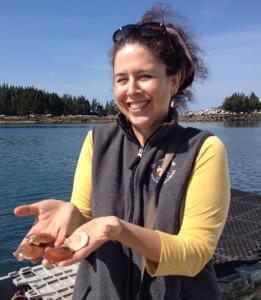Use an Analogy to Pack a Punch: Togue Brawn shows you how
 Two weeks ago, I heard one of the coolest examples of how analogies make your point pack a punch. It happened at a “pitch fest” hosted by the Maine Center for Entrepreneurial Development’s Top Gun program.
Two weeks ago, I heard one of the coolest examples of how analogies make your point pack a punch. It happened at a “pitch fest” hosted by the Maine Center for Entrepreneurial Development’s Top Gun program.
Ten entrepreneurs pitched their ideas to an audience of several hundred, competing for a $10,000 prize. It was also a chance to hone their pitch craft.
Several entrepreneurs stood out for their speaking skill.
One of them was Togue Brawn, founder of Maine Dayboat Scallops. who will be speaking on June 24th at the upcoming Maine Startup and Create Week.
First, she clearly had passion for the impact her business would have in the lives of her customers and the fishermen she served.
In fact, after the event, I was talking about what a dynamo she was to a seasoned angel investor–a man who has seen it all. He laughed and said, in true When Harry Met Sally fashion–“Yeah…I want whatever she’s having!”
Besides her passion, one of the other aspects of Togue’s talk that stood out for me was how she used a powerful analogy to capture the difference her business makes.
In Made to Stick, Chip and Dan Heath cite analogies as being one of the six power tools of the communicator who wants to make their idea “sticky”–i.e. people can’t get it out of their heads.
Why are analogies such a powerful communication tool?
- They translate the unfamiliar into the familiar…making your idea easier to understand.
- They translate the abstract into the tangible. The brain has a much easier time processing concrete images and situations from real life than it does making sense out of abstract concepts. Also, because concrete images and real life situations have a strong sensory component, they evoke more emotions that abstract ideas that only involve the intellect. BTW…notice that this point is an abstract concept. Now…let’s share a specific situation and concrete image that will make this point much more understandable.
Before you hear Togue’s analogy, here’s some quick context, so it makes more sense…
As part of her Origin Story, she shared her epiphany about the plight of Maine’s scallop fishermen and their customers. Most commercially fished scallops that are caught in federal waters in boats that are out to sea for a week or more. These scallops, when sold to consumers as “fresh” can be 12 days old. Maine’s scallop fishermen are all of the dayboat variety, meaning they go out and come back with their catch in one day.
Their scallops are a day old. But…because no delivery system existed to get these into customers’ hands, Maine day scallop fishermen can’t charge the premium price their premium product deserves. Instead, their uber-fresh scallops have to go to the same processing plants as the federal water harvested scallops that are several day’s old. So day old scallops get mixed in with a week or more old scallops.
Now here’s the analogy Togue used to make her point about how this didn’t make sense:
“That’s like pouring a bottle of Dom Perignon into a bathtub of Barefoot bubbly,” she noted.
When I heard that, I thought “Score! What a way to capture the difference.”
While there’s a reason why Barefoot wine is a popular brand, there’s a reason why Dom Perignon has a cachet that popular consumer brands’ don’t. If you made Dom Perignon, would you want it blended into any popular consumer wine and sold at that price or…would you want to get the price your product should command?
While giving the factual differences between scallops harvested in federal waters vs. those harvested by local scallop fishermen made for a clear comparison at the abstract, intellectual level, Togue’s analogy made it tangible. The listener could instantly get the difference at a deeper, more experiential level.
Hence, the power of a good analogy.
So…if you want YOUR ideas to pack a punch, start generating analogies to make your points hit home.
To learn more about how to use analogies and stories to make your ideas more interesting and persuasive, come to:
Tell a better story. Become more interesting. Grow your business.
June 24rd · 12:45PM-1:45PM
Who should attend: Business owners, self-employed professionals, leaders and others who want to communicate the value of their ideas, service, and business in a more compelling, interesting, and persuasive way… whether in front of a group or one-to-one.
Where: O’Maine Studio
Fee: $10 for attendees at Maine Startup and Create Week, $15 for non-attendees (includes lunch)
A Maine Startup & Create Week Partner Program
